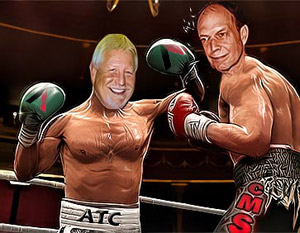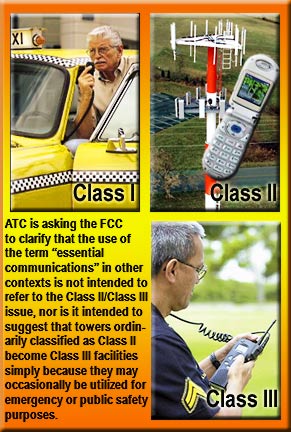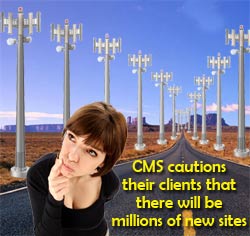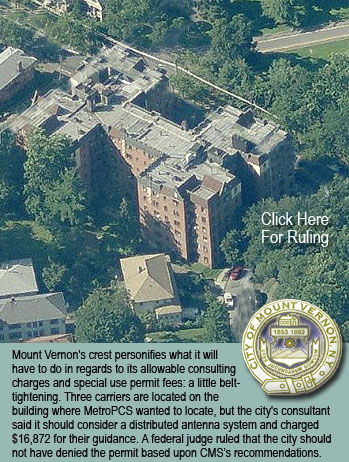American Tower puts on the gloves and
pummels a siting consultant before the FCC
October 8, 2011 - While PCIA panelists this week in Dallas, Tex. were discussing strategies for overcoming the variety of local level barriers to a national broadband  rollout, American Tower Corporation was operating at the federal level by taking a number of well-placed jabs at one of the nation's most adversarial siting consultants - The Center for Municipal Solutions. rollout, American Tower Corporation was operating at the federal level by taking a number of well-placed jabs at one of the nation's most adversarial siting consultants - The Center for Municipal Solutions.
In a filing from ATC released by the FCC on October 3, Paul Roberts, Vice President - Compliance, requested that the Commission should clarify that its use of the term “essential communications” in other proceedings is not intended to suggest that towers used as a platform for commercial wireless service are Class III facilities under the TIA-222-G design standard.
Roberts said that it could have the unintended result of requiring all new towers, and any collocations on or modifications to existing towers, to comply with substantially more rigorous construction requirements.
Consultants said to be misinterpreting Revision G
He said community consultants are misinterpreting the ANSI/EIA/TIA-222-G design standard for towers and are delaying collocations and modifications to existing wireless facilities as well as new builds.
 ATC said that CMS is one of those consultants, taking them to task for adopting a policy that incorrectly states that all wireless towers must be considered Class III structures because “they are used for 'essential communications' during emergency conditions,” regardless of whether they are used “primarily” for that purpose. ATC said that CMS is one of those consultants, taking them to task for adopting a policy that incorrectly states that all wireless towers must be considered Class III structures because “they are used for 'essential communications' during emergency conditions,” regardless of whether they are used “primarily” for that purpose.
In one case, ATC said, CMS would not accept a statement from a state building official identifying that CMS’s reading of the Class II/Class III distinction was incorrect.
ATC said it also showed CMS documentation that neither the wireless industry nor its standard-setting TIA-222 committee believe that commercial wireless towers are Class III facilities and must be built as such.
Undaunted, CMS advised ATC that it will not be persuaded until ATC obtains a clarification from the Commission that the agency’s use of the term “essential communications” in other contexts has nothing to do with TIA-222-G.
ATC said the cost differential between a Class II structure and a Class III structure can range from 30% to 200% more.
Roberts also pointed out that CMS's inflexibility to agree with the design intent of TIA-222-G is another way that CMS will thwart, or at the very least, delay new towers, collocations and modifications to existing antenna structures.
Further identifying CMS's obstructionist views, Roberts noted that on CMS's web site the company advises municipalities that “[i]n all but the most rural locales today, a new tower should be an aberration . . .”.
A rich history of using questionable statistics
"We are the oldest, most experienced & largest public sector organization of our kind in the nation, representing more than 700 communities in 32 states," CMS promotes on its web site. On another page their client base drops to 500. In a news  report in 2010, co-founder Richard Comi said it had grown to 1,000 in 30 states. report in 2010, co-founder Richard Comi said it had grown to 1,000 in 30 states.
CMS says they're a clearing house for industry information, but if they are a central office for the collection and dissemination of cell site information, they're not identifying their research methods and why their statistics appear to be far removed from all other industry estimates.
In 2001, CMS said by 2008 there would be another one million cell sites built.
"Most people are not aware of the fact the wireless telecommunications industry has acknowledged that it will need as many as 1 million more facilities (i.e. sites) in the next several years," CMS said again in 2008, indicating that by today there should be a minimum of two million cell sites.
Not only are most people not aware of those fear-promoting statistics, no industry groups or government organizations would agree with those inflated numbers.
CTIA reported that at the end of 2010, according to its research, there were 253,086 cell sites, which includes all towers.
During CTIA's March show in Orlando, FCC Chairman Julius Genachowski said during the keynote session, "According to industry studies, the 40,000 towers needed for this next generation network will create 53,000 jobs," bringing CTIA's total to approximately 300,000, leaving a deficit of at least 1,700,000 cell sites, if CMS's statistics were credible.
Last year in a white paper the FCC said that cell site growth was going to be flat over the next five years, showing a modest 7% growth each year, in part, because much of the macrocellular networks have been built.
It's difficult to identify when CMS added new content to their site since all pages appear to have been updated this month, but in an almost TV-pitchman style, CMS now says: "The latest news from the industry (with the advent of 2.5 and 3.0 generation technology) is that the industry will need between 4 and 16 times as many sites as previously estimated, depending upon the type of service, e.g. cellular versus PCS."
Presuming CMS's previous "industry" outlook which says the U.S. should now have two million sites is correct, with the highest growth scenario now being advanced, that would indicate that the U.S. will shortly have 32 million cell sites - approximately one cell site for every nine cell phone subscribers.
Amongst other questionable statistics, CMS's web site states that 50% of the wireless communications towers built since the 1996 Telecommunications Act was adopted don’t need to exist.
Along with alerting potential clients to their belief that "[obstruction] lighting can be prohibited," CMS also states that tower collapses and failures are a major problem, especially with the accelerated deployment in recent years.
Although the engineering community says CMS cannot provide any documentation regarding their assertions, CMS states on their web site that in 1999, alone, more than 400 towers collapsed, most of which were preventable because they were due to structural design inadequacies.
PCIA points out CMS's exorbitant fees and delay tactics
In comments to the FCC in July, PCIA said that if the wireless industry is going to achieve the National Broadband Plan’s goal to lead the world in mobile innovation, with the fastest and most extensive wireless networks of any nation, the Commission must address delays caused by a number of municipal consultants.
"The use of some municipal consultants to review wireless infrastructure siting applications can significantly delay and add expense to infrastructure deployments to the detriment of the consumer utilizing wireless services," said Michael Fitch, President and CEO of PCIA in the trade organization's comments to the FCC.

"In July 2010, a federal court realized the detrimental impact that some municipal
consultants have on the siting of wireless infrastructure," Fitch stated, identifying the case of MetroPCS v. the City of Mt. Vernon where the NY court found that the city, upon CMS's recommendation, had unreasonably discriminated against MetroPCS by denying it the ability to collocate on a building which already supported three other wireless providers without a valid reason.
PCIA said the collocation application process took 15 months and cost MetroPCS over $16,000 in consultant fees.
In that case, the court found CMS's fees unreasonable and ordered returning some of the fees because part of the review for which the consultant was compensated involved “repeatedly requesting unnecessary information and belaboring issues already resolved.”
PCIA said that the Commission should begin an extensive educational campaign - and suggested using the CMS case - as a way to alert local jurisdictions of the importance of wireless services as part of its national goals and recommend ways that a local jurisdiction can streamline its collocation-review process.
CMS co-owner Rusty Monroe was a guest speaker four years ago during a meeting of the Alabama Wireless Association, where he discussed the implementation of his firm's wireless telecommunications ordinance.
His appearance emphasized the wireless infrastructure industry's need to keep their friends close and their enemies closer.
New resources officer and federal template on ATC's wish list
ATC also asked the Commission in its September 30 filing to:
-- Commit additional resources to its review of siting applications under the National Environmental Protection Act and the National Historic Preservation Act.
-- Appoint a Natural Resources Officer to oversee and help expedite the NEPA review process for siting of wireless facilities.
-- Work directly with other Federal agencies to create a uniform, streamlined template for the processing of applications to construct or install wireless facilities on Federal Government property.
-- Regarding the problem of "legal, non-conforming uses," adopt a rule stating that preclusion of collocators is "unreasonably discriminatory," including where a tower used by one or more providers has been deemed non-conforming due to changes in local regulations enacted after the underlying facility was constructed. ATC also asked for the rule to apply to tower modifications.
|